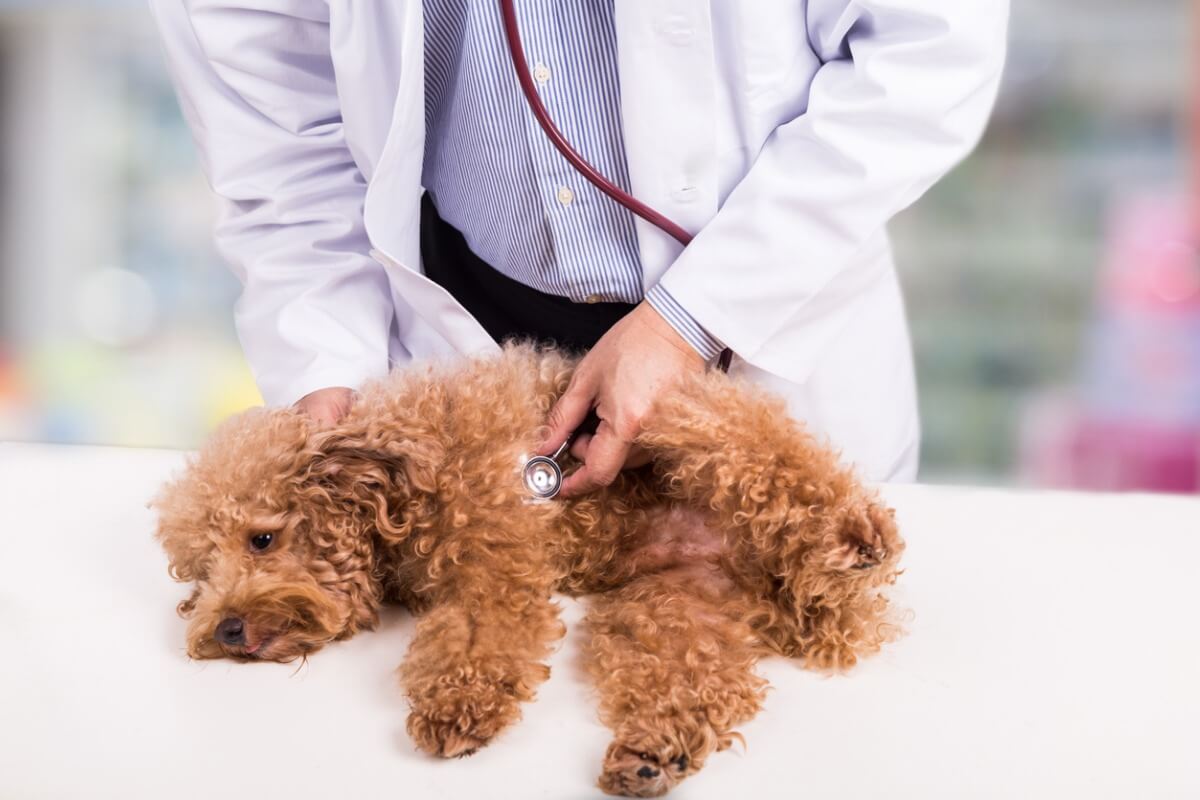Lumps in Dogs: Causes and Treatment


Written and verified by the biologist Georgelin Espinoza Medina
All dog owners are concerned about their dogs’ health. Lumps in dogs are one of the most frequent concerns, as they can appear in any dog, regardless of breed, sex or age. They can appear due to many different factors, and aren’t necessarily serious, although they need to be treated with care.
Ideally, you should always consult an expert who can define the cause and prescribe an appropriate treatment. In order to guide you on the subject, we’re bringing you this article dedicated to the lumps on our dogs’ skin, why they appear, and how to get rid of them. Don’t miss it!
What are lumps in dogs?
Lumps can appear in any breed, sex, or part of the animal’s body, depending on the cause. There are different types of lumps in dogs, and they aren’t all the same. They can vary in size, consistency (hard or soft), and also in number (as sometimes more than one appears).
We must be very attentive and observe all the factors and characteristics of the lumps that we see on our pet, in order to provide the veterinarian with as much information as possible.
Among the main types of lumps in dogs, we have cysts, abscesses (accumulation of pus) and neoplasms, products of uncontrolled cell growths.
Cutaneous neoplasms account for one-third of the tumor processes in dogs and can be benign or malignant. The most frequent ones include squamous cell carcinoma, lipomas, mastocytomas, and basal cell tumors.

Causes of lumps in dogs
As well as the diversity of lumps in these pets, there are also different factors that cause them. Thus, we have the following:
- Blows and wounds: It’s common for a swollen area to occur in your pet due to a blow, accident, bite, or any type of laceration. Thus, reddening of the area and hematoma may occur, but these signs usually disappear after a short time. If wounds aren’t properly treated, abscesses can form on a dog’s skin. When they’re the result of fights, the frequent areas where these lumps occur are the neck, face, and back.
- Vaccine administration: Sometimes, when a vaccine or medication is administered, lumps can occur, although they aren’t very common. They appear in the neck or the withers area, according to the area of the injection. They usually disappear after a short time, without causing major problems.
- Blockage of sebaceous glands: Some lumps can also form due to the obstruction of the sebaceous glands of our pet’s skin.
- Diseases: Some lumps are the sign of some underlying disease in the dog. If they’re due to infections, they produce inflammation in the lymph nodes. Skin tumors are caused by the formation of uncontrolled cell growth. They should be evaluated, as they may be indicative of cancer. Lumps can also be caused by allergies or exposure to irritants or toxic substances. In addition, some warts indicate the presence of important viruses such as the canine papilloma virus.
Treatments for lumps in dogs
The procedures to eradicate these lumps in canines are diverse. In particular, they depend on the factor behind the problem.
As we have seen, some lumps don’t involve much treatment, and they can even disappear on their own, as in the case of those due to vaccination or even hematomas. However, the administration of anti-inflammatory drugs may also be necessary.
For abscesses, anti-inflammatory treatment, lump drainage, cleaning, disinfection, and antibiotics to inhibit bacterial growth is usually implemented. In larger lumps, surgical intervention may be necessary.
Antibiotics may also be useful in lymph node inflammation. However, the condition should be evaluated, as other pathogens or foreign agents may be involved, which may require other drugs.
Some tumors don’t cause major problems. However, it’s best to have a specialist thoroughly analyze each case and perform other tests to differentiate whether it’s a malignant or benign tumor or any other type of lump.
Surgery may be performed to remove the entire lump and surrounding tissue. In addition, further analysis can be performed to have a more complete view of the problem.

Always rely on an expert’s opinion
Whatever the case, you should always consult your veterinarian, regardless of the characteristics of the lumps in dogs. As soon as you notice them, you should get an appointment with an expert, who will make a timely and exhaustive diagnosis, and then follow their indications regarding treatment. Our dog’s health should be taken seriously and they deserve the best care they can get.
All dog owners are concerned about their dogs’ health. Lumps in dogs are one of the most frequent concerns, as they can appear in any dog, regardless of breed, sex or age. They can appear due to many different factors, and aren’t necessarily serious, although they need to be treated with care.
Ideally, you should always consult an expert who can define the cause and prescribe an appropriate treatment. In order to guide you on the subject, we’re bringing you this article dedicated to the lumps on our dogs’ skin, why they appear, and how to get rid of them. Don’t miss it!
What are lumps in dogs?
Lumps can appear in any breed, sex, or part of the animal’s body, depending on the cause. There are different types of lumps in dogs, and they aren’t all the same. They can vary in size, consistency (hard or soft), and also in number (as sometimes more than one appears).
We must be very attentive and observe all the factors and characteristics of the lumps that we see on our pet, in order to provide the veterinarian with as much information as possible.
Among the main types of lumps in dogs, we have cysts, abscesses (accumulation of pus) and neoplasms, products of uncontrolled cell growths.
Cutaneous neoplasms account for one-third of the tumor processes in dogs and can be benign or malignant. The most frequent ones include squamous cell carcinoma, lipomas, mastocytomas, and basal cell tumors.

Causes of lumps in dogs
As well as the diversity of lumps in these pets, there are also different factors that cause them. Thus, we have the following:
- Blows and wounds: It’s common for a swollen area to occur in your pet due to a blow, accident, bite, or any type of laceration. Thus, reddening of the area and hematoma may occur, but these signs usually disappear after a short time. If wounds aren’t properly treated, abscesses can form on a dog’s skin. When they’re the result of fights, the frequent areas where these lumps occur are the neck, face, and back.
- Vaccine administration: Sometimes, when a vaccine or medication is administered, lumps can occur, although they aren’t very common. They appear in the neck or the withers area, according to the area of the injection. They usually disappear after a short time, without causing major problems.
- Blockage of sebaceous glands: Some lumps can also form due to the obstruction of the sebaceous glands of our pet’s skin.
- Diseases: Some lumps are the sign of some underlying disease in the dog. If they’re due to infections, they produce inflammation in the lymph nodes. Skin tumors are caused by the formation of uncontrolled cell growth. They should be evaluated, as they may be indicative of cancer. Lumps can also be caused by allergies or exposure to irritants or toxic substances. In addition, some warts indicate the presence of important viruses such as the canine papilloma virus.
Treatments for lumps in dogs
The procedures to eradicate these lumps in canines are diverse. In particular, they depend on the factor behind the problem.
As we have seen, some lumps don’t involve much treatment, and they can even disappear on their own, as in the case of those due to vaccination or even hematomas. However, the administration of anti-inflammatory drugs may also be necessary.
For abscesses, anti-inflammatory treatment, lump drainage, cleaning, disinfection, and antibiotics to inhibit bacterial growth is usually implemented. In larger lumps, surgical intervention may be necessary.
Antibiotics may also be useful in lymph node inflammation. However, the condition should be evaluated, as other pathogens or foreign agents may be involved, which may require other drugs.
Some tumors don’t cause major problems. However, it’s best to have a specialist thoroughly analyze each case and perform other tests to differentiate whether it’s a malignant or benign tumor or any other type of lump.
Surgery may be performed to remove the entire lump and surrounding tissue. In addition, further analysis can be performed to have a more complete view of the problem.

Always rely on an expert’s opinion
Whatever the case, you should always consult your veterinarian, regardless of the characteristics of the lumps in dogs. As soon as you notice them, you should get an appointment with an expert, who will make a timely and exhaustive diagnosis, and then follow their indications regarding treatment. Our dog’s health should be taken seriously and they deserve the best care they can get.
All cited sources were thoroughly reviewed by our team to ensure their quality, reliability, currency, and validity. The bibliography of this article was considered reliable and of academic or scientific accuracy.
- Pacheco, M. (2020). Revisión bibliográfica de abscesos cutáneos, etiología, signos clínicos, fisiopatología, diagnóstico y tratamiento convencional y quirúrgico en perros. [Tesis de grado, Universidad Técnica de Machala]. http://repositorio.utmachala.edu.ec/bitstream/48000/16116/1/ECUACA-2020-MV-DE00006.pdf
- Martínez, J., & García, J. (2021). Neoplasias cutáneas en caninos (Canis lupus familiaris) remitidos al laboratorio División Veterinaria en el periodo 2018-2020. [Tesis de grado, Universidad Nacional Agraria]. https://repositorio.una.edu.ni/4340/1/tnl73m385n.pdf
- Medina, I., Puicón, V., & Sandoval, N. (2017). Frecuencia de tumores en piel de caninos diagnosticados histopatológicamente en el laboratorio de patología veterinaria de la Universidad Nacional Mayor de San Marcos (1999-2012). Revista de Investigaciones Veterinarias del Perú, 28(2), 448-454.
- Torres, M.; Pino, D.; Zamora, Y., & Matos, R. (2020). Consideraciones actuales sobre las neoplasias cutáneas en la especie canina. Revista de Salud Animal, 42(2), e05.
This text is provided for informational purposes only and does not replace consultation with a professional. If in doubt, consult your specialist.








